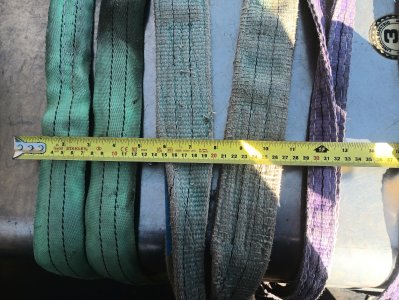TorontoBuilder
Sapientia et Doctrina Stabilitas
So, I thought that this project was on hold until spring.
Last night our friend Dave from Guelph stopped by my brother's. They got to talking about this project and Dave said he wanted to get this done this fall. They decided that my lathe needed to go to Guelph again to be sand blasted this fall too.
So today instead of moving it a few kilometers it became much more involved, and sketchy. Wheeled the lathe out of the garage on pallet truck. Lifted enough to remove pallet.

Cleared everything out of the way except the crane and the lathe.

Hoisted the lathe. Without the motor, motor mount and variator it was unbalanced a bit towards the tailstock end but not so much a person leaving in towards the lathe couldn't push it level. Once up 6" the lathe was spun 180 degrees to put the headstock in front of the axle to balance the load in the trailer. Then hoisted to 6" above the trailer deck, dropped pallet into trailer.
Backed trailer into position. Lowered lathe, and strapped it down.

The binding straps pass thru holes in the bed and go to the front and the rear of the trailer. It can't move at all. Put crane into trailer and secured it separately, put the loose lathe parts into the back of the SUV and away we went. 90 kph to Guelph...

In Guelph we had no driveway, so had to lay down boards to be able to move the pallet truck. This is just after I pulled the trailer ahead and Dave and Tom were spinning the lathe to align with the pallet. They seem so unconcerned even after I told them a dozen times I was a little worried about that strap. It is old

Now it is all tucked away in the wood shed. Not really a shed but what else can you call it? Next move only requires a pallet truck

Last night our friend Dave from Guelph stopped by my brother's. They got to talking about this project and Dave said he wanted to get this done this fall. They decided that my lathe needed to go to Guelph again to be sand blasted this fall too.
So today instead of moving it a few kilometers it became much more involved, and sketchy. Wheeled the lathe out of the garage on pallet truck. Lifted enough to remove pallet.
Cleared everything out of the way except the crane and the lathe.
Hoisted the lathe. Without the motor, motor mount and variator it was unbalanced a bit towards the tailstock end but not so much a person leaving in towards the lathe couldn't push it level. Once up 6" the lathe was spun 180 degrees to put the headstock in front of the axle to balance the load in the trailer. Then hoisted to 6" above the trailer deck, dropped pallet into trailer.
Backed trailer into position. Lowered lathe, and strapped it down.
The binding straps pass thru holes in the bed and go to the front and the rear of the trailer. It can't move at all. Put crane into trailer and secured it separately, put the loose lathe parts into the back of the SUV and away we went. 90 kph to Guelph...
In Guelph we had no driveway, so had to lay down boards to be able to move the pallet truck. This is just after I pulled the trailer ahead and Dave and Tom were spinning the lathe to align with the pallet. They seem so unconcerned even after I told them a dozen times I was a little worried about that strap. It is old
Now it is all tucked away in the wood shed. Not really a shed but what else can you call it? Next move only requires a pallet truck



